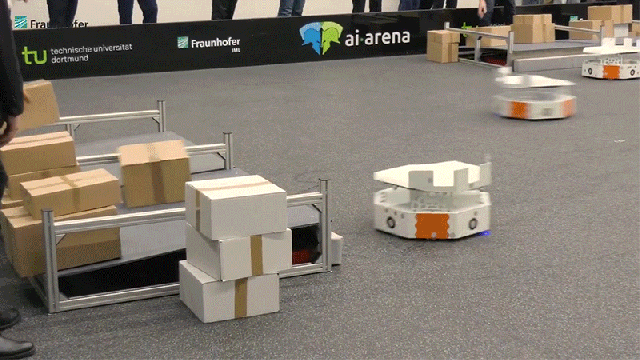Modern warehouses are a hive of frenetic activity as robots and humans move boxes around as quickly as possible. To shave a few precious seconds off a delivery, researchers in Germany have developed a high-speed robotic drone that unloads packages by deliberately crashing into a platform and letting inertia take care of the rest.
The robots, which look like upgraded robovacs, were designed and engineered at the Fraunhofer Institute for Material Flow and Logistics where they’ve been nicknamed LoadRunners, presumably inspired by the classic ‘80s Lode Runner platformer where a character runs around a level collecting gold pieces. The robotic drones can carry everything from boxes to suitcases (up to 30kg) to long trusses that require a pair of them to work in tandem, but depending on the payload, the bots can hit an impressive top speed around 35 km per hour allowing them to quickly scurry around a warehouse.
That much speed also gives the bots a lot of inertia: something they use to further expedite their deliveries. Instead of carefully rolling up to a drop-off point where a mechanism unloads a package or a human worker physically grabs it, the bots just slam into a shock-absorbing bumper and come to an immediate stop, sending the package sliding off all on its own. It’s fast, it’s efficient, and it’s completely dependent on whatever’s inside the box being properly packaged and protected with loads of bubble wrap or packing peanuts. If this is where the industry is going, you might want to rethink buying fancy vases, glassware, or ceramics online.
The LoadRunners might be programmed to deliberately crash into drop-off spots, but a warehouse doesn’t want those types of crashes randomly happening elsewhere, which is a real possibility when hundreds of these robots are zipping around at 35 km/h. To ensure that never happens, the robots are also programmed with swarm behaviours. Similar to a flock of birds where each one takes directional cues from nearby birds, the LoadRunner robots are all packed with sensors that track the position, speed, and direction of the robots around them, allowing them to make quick course adjustments to avoid accidents. The approach means no central control system is needed, nor are expensive sensors placed all over the warehouse to keep an eye on things.
Each robot also makes use of a camera pointed at the ground which snaps 400 images every second of the floor passing beneath it, allowing it to know its orientation and accurately determine its location, which is presumably assisted with patterns or markers applied to the ground. That might be the biggest advantage of these drones, they can be used to easily upgrade an older facility with a level of autonomy without having to install millions of dollars worth of permanent infrastructure like conveyor belts. You just clean the floors, clear out as many obstacles as possible, paint a few lines on the floor, and suddenly you’ve ready for a small army of robots scurrying around like every day is their first day and they’re trying to make a good impression.
